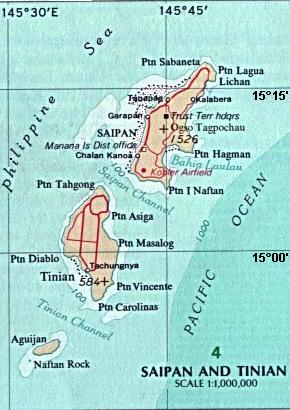Tinian, Northern Mariana Islands





Tinian (Template:PronEng, /ˌtiːniˈɑːn/) is one of the three principal islands of the Commonwealth of the Northern Marianas Islands (14°59’51”N, 145°37’39”E). It is perhaps best known for being the base from which the American atomic bomb attacks on Japan during World War II were launched.
Geography
Tinian is about 5 miles (8km) southwest of its sister island, Saipan, and has a land area of 39 sq.mi. (101.01 km²). Together with uninhabited neighboring Aguijan Island (2.74 sq mi, or 7.09 km²), it forms Tinian Municipality, one of the four constituent municipalities of the Northern Marianas. The total area of the municipality is 41.74 sq mi (108.1 km²). Tinian's largest village is San Jose.
The Island has a variety of flora and fauna, as well as limestone cliffs and caves. There is also a variety of marine life and coral reefs surrounding the island. Its clear, warm waters are ideal for snorkeling and scuba diving, as well as sport fishing.
Points of interest
Tinian has two gas stations and a Casino, The Dynasty, which includes a luxury hotel, shops and restaurants and is adjacent to Tachogna beach and Taga Beach. The village of San Jose has several smaller hotels and restaurants and bars. The airport is small and serviced by two airlines, Freedom Air, which operates daily scheduled flights, and Taga Air, which operates by charter. There is also ferry boat service twice daily between Tinian and Saipan.
Other points of interest on the Island include the North Field, where the remains of the US bomber base and Atom Bomb Pits as well as the remains of Japanese fortifications can be found. The island also has the only intact Shinto shrine on the Mariana Islands.
There are also the ruins of the House of Chief Taga, one of the Chiefs of the Mariana Islands during the Pre-Spanish period. The House of Taga is a Latte stone site, one of the largest such structures in the Marianas. The stones are quarried limestone, each approximately 20 feet in length. Of the twelve large Latte structures, only one is still standing.
Much of the local economy is dependent on tourism. The largest employers on the island are the Government and the Casino.
As of March 2006, the island has plans to put in four new casinos. The 2000 census showed a population of 3,540 [1] for the island.
World War II
Lightly populated, but heavily garrisoned by Japanese forces in World War II, Tinian, with its sister islands, had passed through Spanish and German hands prior to becoming a Protectorate of Japan after World War I. Under Japanese administration, Tinian was largely a sugar plantation.
Tinian was captured by the United States in July 1944 in the battle of Tinian. The island was transformed into the busiest airbase of the war, with two B-29 airfields (West and North) having six 8,500 foot (2700 m) runways. The Japanese had constructed three small fighter strips on Tinian but none were suitable for bomber operations. When the United States turned the entire island, excepting its three highland areas, into a 40,000-personnel installation, construction engineers laid out the base in a pattern of city streets resembling Manhattan and named the streets accordingly. The area south of West Field which was developed from the main Japanese installation at Sunharon was nicknamed "The Village" because its location corresponded to that of Greenwich Village, and a large square area between West and North Fields, used primarily only for the location of the base hospitals and otherwise left undeveloped was called Central Park.
It was from Tinian that the bombers carrying the atomic bombs Little Boy and Fat Man were launched against Hiroshima and Nagasaki. The bomb had been delivered to the island by the USS Indianapolis on 26 July 1945.
The airfields are now overgrown and abandoned. There is a memorial on the old airfield at the loading pits, which had been filled in for safety. Both pits were recently reopened in conjunction with the 60th Anniversary Commemoration of the Battles of Saipan and Tinian. Originally the pits had been constructed to load the large bombs, since each bomb was too large to be loaded in the conventional manner. The planes were maneuvered over a pit with their bomb bay doors open to facilitate loading.
Education
Commonwealth of the Northern Mariana Islands Public School System operates public schools. Tinian also has Grace Christian Academy, the only private school on the island.

